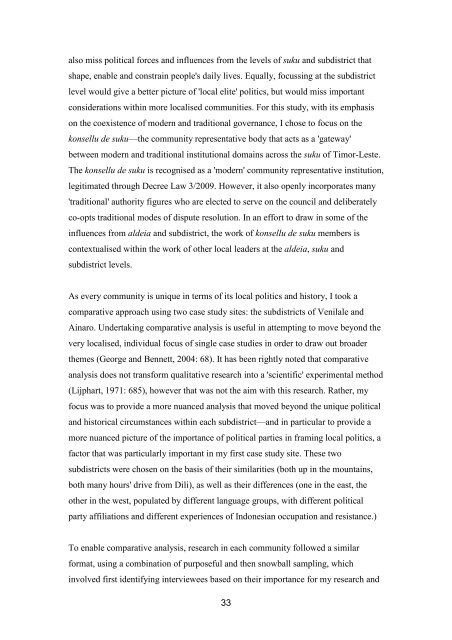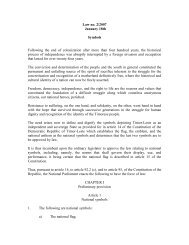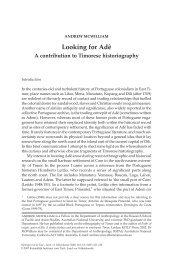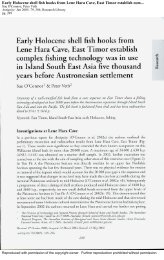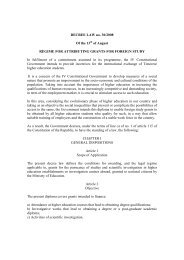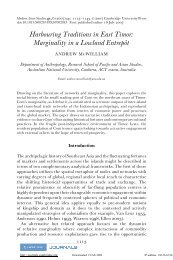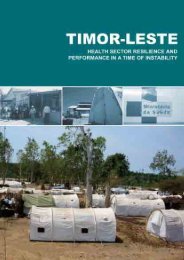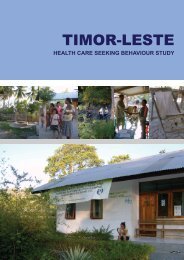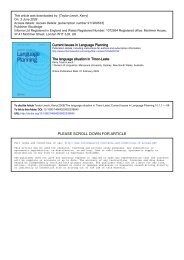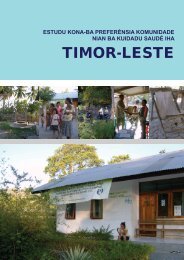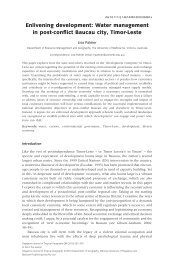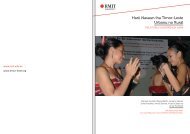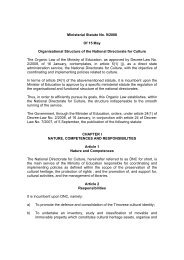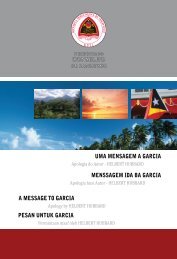Local Governance in Timor-Leste - Secretaria de Estado da Arte e ...
Local Governance in Timor-Leste - Secretaria de Estado da Arte e ...
Local Governance in Timor-Leste - Secretaria de Estado da Arte e ...
- No tags were found...
Create successful ePaper yourself
Turn your PDF publications into a flip-book with our unique Google optimized e-Paper software.
also miss political forces and <strong>in</strong>fluences from the levels of suku and subdistrict thatshape, enable and constra<strong>in</strong> people's <strong>da</strong>ily lives. Equally, focuss<strong>in</strong>g at the subdistrictlevel would give a better picture of 'local elite' politics, but would miss importantconsi<strong>de</strong>rations with<strong>in</strong> more localised communities. For this study, with its emphasison the coexistence of mo<strong>de</strong>rn and traditional governance, I chose to focus on thekonsellu <strong>de</strong> suku—the community representative body that acts as a 'gateway'between mo<strong>de</strong>rn and traditional <strong>in</strong>stitutional doma<strong>in</strong>s across the suku of <strong>Timor</strong>-<strong>Leste</strong>.The konsellu <strong>de</strong> suku is recognised as a 'mo<strong>de</strong>rn' community representative <strong>in</strong>stitution,legitimated through Decree Law 3/2009. However, it also openly <strong>in</strong>corporates many'traditional' authority figures who are elected to serve on the council and <strong>de</strong>liberatelyco-opts traditional mo<strong>de</strong>s of dispute resolution. In an effort to draw <strong>in</strong> some of the<strong>in</strong>fluences from al<strong>de</strong>ia and subdistrict, the work of konsellu <strong>de</strong> suku members iscontextualised with<strong>in</strong> the work of other local lea<strong>de</strong>rs at the al<strong>de</strong>ia, suku andsubdistrict levels.As every community is unique <strong>in</strong> terms of its local politics and history, I took acomparative approach us<strong>in</strong>g two case study sites: the subdistricts of Venilale andA<strong>in</strong>aro. Un<strong>de</strong>rtak<strong>in</strong>g comparative analysis is useful <strong>in</strong> attempt<strong>in</strong>g to move beyond thevery localised, <strong>in</strong>dividual focus of s<strong>in</strong>gle case studies <strong>in</strong> or<strong>de</strong>r to draw out broa<strong>de</strong>rthemes (George and Bennett, 2004: 68). It has been rightly noted that comparativeanalysis does not transform qualitative research <strong>in</strong>to a 'scientific' experimental method(Lijphart, 1971: 685), however that was not the aim with this research. Rather, myfocus was to provi<strong>de</strong> a more nuanced analysis that moved beyond the unique politicaland historical circumstances with<strong>in</strong> each subdistrict—and <strong>in</strong> particular to provi<strong>de</strong> amore nuanced picture of the importance of political parties <strong>in</strong> fram<strong>in</strong>g local politics, afactor that was particularly important <strong>in</strong> my first case study site. These twosubdistricts were chosen on the basis of their similarities (both up <strong>in</strong> the mounta<strong>in</strong>s,both many hours' drive from Dili), as well as their differences (one <strong>in</strong> the east, theother <strong>in</strong> the west, populated by different language groups, with different politicalparty affiliations and different experiences of Indonesian occupation and resistance.)To enable comparative analysis, research <strong>in</strong> each community followed a similarformat, us<strong>in</strong>g a comb<strong>in</strong>ation of purposeful and then snowball sampl<strong>in</strong>g, which<strong>in</strong>volved first i<strong>de</strong>ntify<strong>in</strong>g <strong>in</strong>terviewees based on their importance for my research and33


